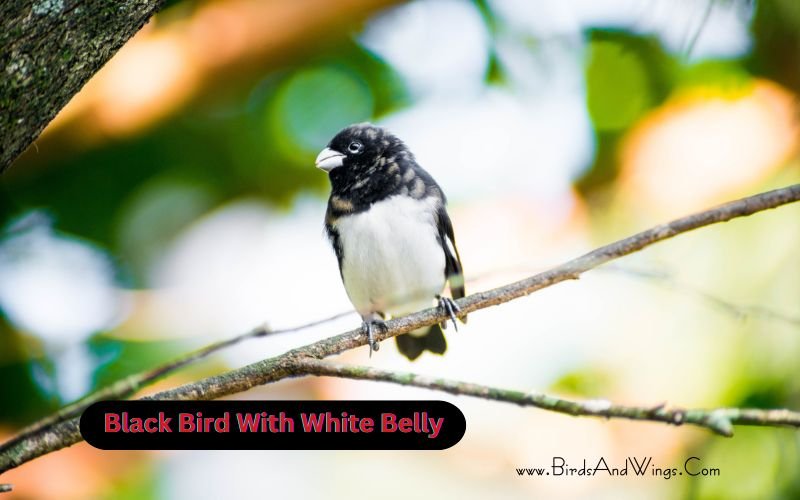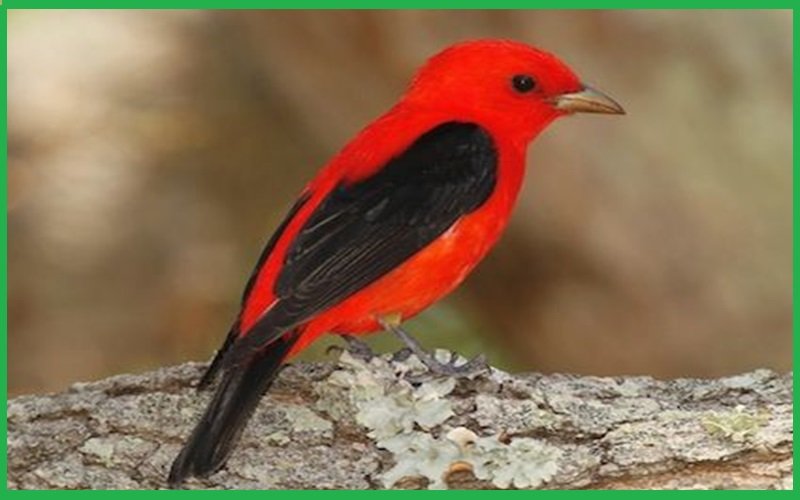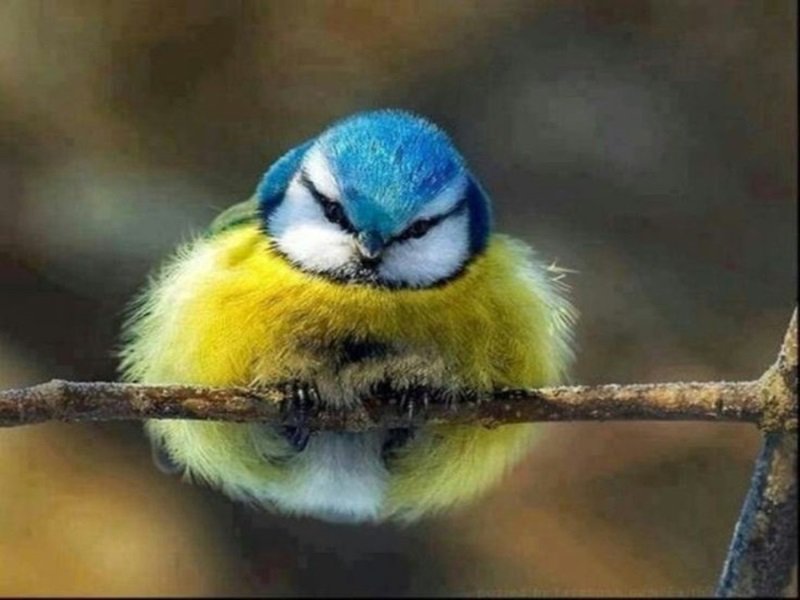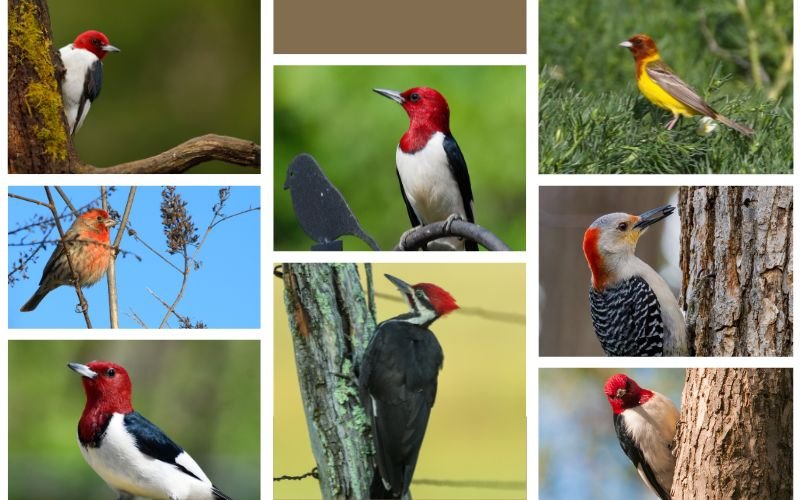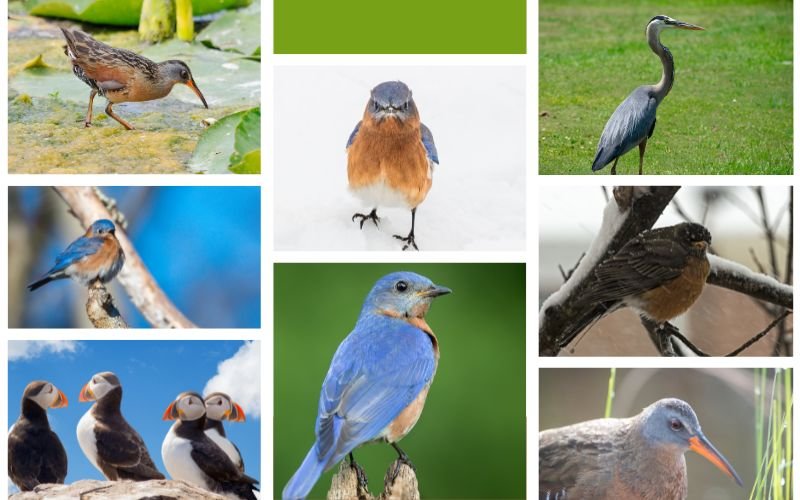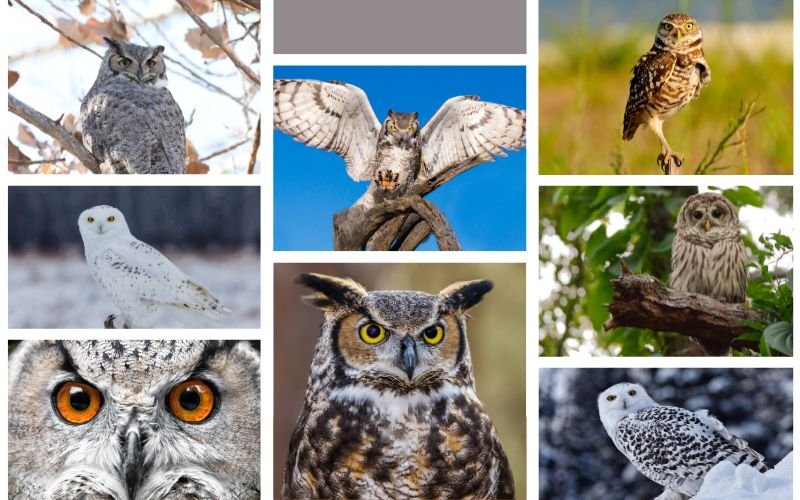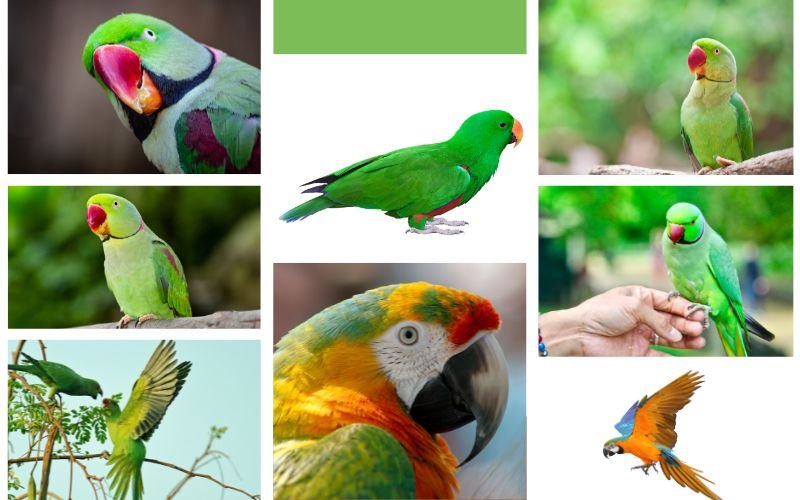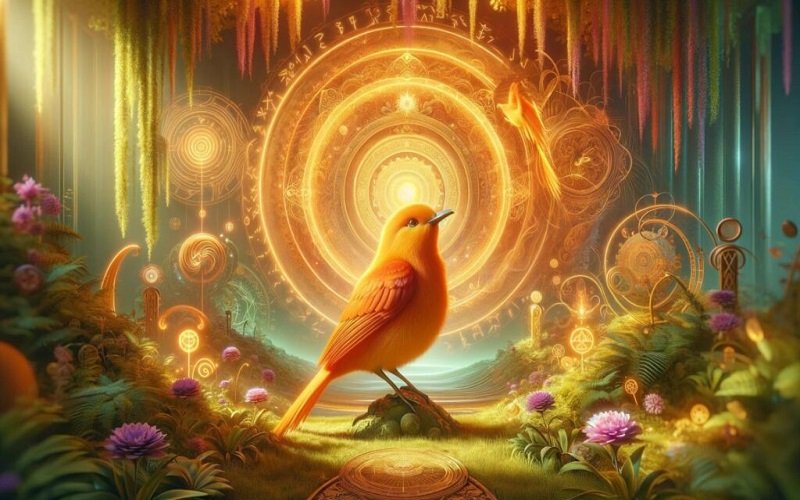The contrasting mix of black and white can create the perfect balance of yin and yang. The colours blend to create shades that can be marvellous or dull, depending on the context.
For bird lovers, the black and white shades create a harmony of soothing, appealing colours on birds. Many bird watchers study the birds, which create an illuminating combination of these colours. Knowing which birds sport black and white feathers, especially the white stripes on their wings, is essential for budding bird lovers.
List of 15 black birds with white stripes on wings
1. White-Headed Woodpecker
- Scientific name: Picoides Albolarvatus
- Lifespan: They can live up to ten years.
- Wingspan: There is no fixed estimate.
- Native to: They can be found in the mountainous range of British Columbia, especially around the pine forests.
They may look bold, but the White-Headed Woodpecker is a shy one! They prefer peaking on the pine seeds but will not say no to small insects and larvae.
With a black body and white feathers on its head and wings, this needs a lot of water because of its dry diet. So if you see one near your home, put out a bowl for it to drink!
2. Hairy Woodpecker
- Scientific name: Leuconotopicus Villosus
- Lifespan: Usually ranges from 11 to 15 years.
- Wingspan: Their wingspan can extend to 15 inches.
- Native to: If you visit Mexico or Panama, you may find them lurking around the trees!
They may be similar to their cousin, the Downy Woodpecker, but they can be deceiving! You can distinguish them by their size and beak shape.
Hairy Woodpeckers are more extensive and have thicker beaks. Both sexes have black feathers with white stripes all over their body. White hair-like feathers are on its back, from which its English name is derived.
They are pretty hyper and linger around trunks of trees to look for food. If you spot one, you can offer it insect-based bird food in a bowl or water to let it quench its thirst.
3. Downy Woodpecker
- Scientific name: Picoides Pubescens
- Lifespan: Usually ranges from 3 to 5 years
- Wingspan: Their wingspan can extend to 12 inches
- Native to: It is not unusual to find them near forests and willows in North America
Speaking of cousins, the Downy Woodpecker is also quite similar to the Hairy Woodpecker in looks. However, these are the smallest woodpeckers in the North American region.
They are friendly and social, seamlessly helping themselves enter the gardens and homes of bird lovers who leave food out for them.
Due to its small size, the Downy Woodpecker adapts to low and high lands. They even like socializing with birds like Chickadees and Nuthatches during winter, flying around in forests.
4. Lark Bunting
- Scientific name: Calamospiza Melanocorys
- Lifespan: They have a short lifespan of five years.
- Wingspan: Their wingspan is around 9.8 to 11 inches.
- Native to: If you want to catch a glimpse of them, try to linger around the grasslands of North America.
The male Lark Buntings are quite the sight during summer because their white stripes stand out even among thick shrubs. They hop around, picking up soft insects from the ground to feast on.
They consume seeds in winter, so if you want to feed them, consider putting a bowl of seeds in your garden.
5. Eurasian Magpie
- Scientific name: Pica Pica
- Lifespan: They live for 3 to 5 years, relatively short.
- Wingspan: Their wingspan is around 21 inches.
- Native to: These birds are native to Spain, Portugal, and Ireland. They prefer to loiter around peninsulas.
The Eurasian Magpies possess a monochrome of black and white feathers, which are sleek and beautiful. Their shiny feathers also reflect green and purple shades under the sun, and it has white feathers on its shoulder.
The Eurasian Magpie can also be found in many regions of Asia like Korea, Siberia etc. They are shy birds which like to stay away from other animals and nest peacefully in deep parts of the forest. A few might be spotted occasionally in urban regions, but they are timid, so it’s best to leave them in peace.
6. Yellow-headed Blackbird
- Scientific name: Xanthocephalus xanthocephalus
- Lifespan: They live for almost 11 years.
- Wingspan: Their wingspan is around 15-inches
- Native to: They’ll be hard to miss at the Riverlands of Mississippi
As you may have guessed, the Yellow-Headed Blackbird has pale yellow feathers covering its head. Its shiny black feathers have a touch of white around the wings. While you may marvel at the bird’s look, try to avoid its singing because it is not a good singer. Its harsh screeches can annoy you.
While the Yellow-Headed Blackbird scavenges for food around areas with low vegetation, it may also follow farmers around to pick out insects from the tractors.
7. Black-and-White Warbler
- Scientific name: Mniotilta varia
- Lifespan: They live for almost 11 years.
- Wingspan: Their wingspan is around 8.1 inches
- Native to: They’re primarily found in Canada and the northern parts of South America
Budding bird lovers will be delighted to know these are the easiest birds to spot. The Black and White Warbler has two stripes of white feathers on its wings and can climb trees to look for food, mainly insects. They are found in wetlands where they look for dormant insects or even catch a few when flying.
If you are keen to feed them, don’t be. They are not friendly, and they’re pretty aggressive despite their appearance.
8. Yellow-bellied Sapsucker
- Scientific name: Sphyrapicus varius
- Lifespan: They usually live around 6 to 7 years
- Wingspan: Their wingspan is around 15 inches
- Native to: They’re primarily found in North America, mainly in Canada and Alaska
The Yellow-Bellied Sapsuckers have a set of feathers of various colours. They have checkered feathers on their back of red and yellow. The rest of their body is predominantly black with white stripes.
They are known to make holes in trees and eat the sap which comes out of the holes. While they are known to treat themselves to insects occasionally, the sap is their favourite food. It won’t refuse berries and fruits, either!
9. Tricolored Blackbird
- Scientific name: Agelaius tricolor
- Lifespan: They usually live up to 13 years.
- Wingspan: Their wingspan is around 13 inches
- Native to: They’re primarily found in the northern parts of California
Both the sexes of the Tricolored Blackbird look similar, but the males have a dash of scarlet on their shoulders. They are rare to spot and stick to the Pacific regions.
These are endangered birds, and their population is roughly 40,000. Since their habitats are being destroyed, many birds nest around farms.
So, if you spot a nest around any farm, ensure that the nest is protected and left untouched by others.
10. Magpie Lark
- Scientific name: Grallina Cyanoleuca
- Lifespan: They have a surprisingly long lifespan of 25 years.
- Wingspan: There is no precise estimate
- Native to: They’re primarily found in Australia
The unique mix of black and white combined with long legs and a sharp beak makes the Magpie Lark a compelling sight. They prefer dry areas, especially the savannahs of Australia. Magpie Larks feast primarily on insects and seeds.
However, they are quite the singers, especially in pairs. They love singing in duets, with each bird chirping sweet tunes synchronized.
11. Anhinga
- Scientific name: Anhinga Anhinga
- Lifespan: They can live up to 12 years
- Wingspan: Their wingspan is almost 42 inches.
- Native to: You may find them in Florida
Their snake-like neck helps them to fish out the food from the water. Literally! The males have black feathers, while the females are of a lovely grey shade, but both have white stripes on their wings.
They are lone rangers and are patient hunters. Even though they can build nests, Anhingas may occupy the nests of Herons.
12. Northern Mockingbird
- Scientific name: Mimus polyglottos
- Lifespan: They can live up to 10 years
- Wingspan: Their wingspan is almost 14 inches
- Native to: You may find them in the USA, Canada, and Mexico
While the Northern Mockingbird looks black from afar, they’re dark grey with white feathers on its wings. In flight, they flash brightly, which makes them stand out.
The Northern Mockingbird is a regular visitor to the gardens in North America, but they are by no means friendly. They are territorial and won’t hesitate to hurt humans if threatened. If you leave out any bird food or water for them, try to stay away from them.
13. Common Nighthawk
- Scientific name: Chordeiles minor
- Lifespan: They can live up to 5 years
- Wingspan: Their wingspan is almost 23 inches
- Native to: They are primarily found in cold Icelandic regions like Greenland, the British Isles, the Azores, and the Faroe Islands.
The Common Nighthawk is dark brown but seems black to the naked eye. The white streaks on their wings are pretty visible, even in flight. If you want to spot one, you may find them lurking around in the wee hours of dawn or twilight. They breed in open lands and are seen frequently in cities.
14. White-browed Wagtail
- Scientific name: Motacilla maderaspatensis
- Lifespan: They can live up to 12 years
- Wingspan: Their wingspan is around 11 inches
- Native to: They’re native to the southern parts of Asia
The White-Browed Wagtail is also black with white stripes on its wings but has a white streak on its head. Like its name, it has a tail which loves to wag, and this peculiar bird can be found in places near water.
In the past, the White-Browed Wagtail were kept as pets, especially in India. Their sweet singing voice made the bird quite famous among Indian noblemen. The bird is also believed to carry an emblem of the Indian god, Vishnu, on its chest. Hence, the bird is sacred in Hinduism.
15. White-winged Triller
- Scientific name: Lalage Tricolor
- Lifespan: They can live for around 3 to 5 years
- Wingspan: There is no precise estimate
- Native to: They’re native to Australia
Undersized with a sweet melody, the White-Winged Triller has beautiful black and white feathers. They have black feathers on their head and back, white underbelly, and white stripes on their wings. While their voices are sweet, they may be too loud when they breed.
The White-Winged Triller eats insects but also indulges in fruits and seeds. They build small nests on branches of forks in trees. If you spot a nest, both parents might be actively incubating the eggs.
FAQ
Are Black Birds With White Bellies and Black Birds With White Stripes on Their Wings the Same Species?
Black birds with white bellies and black birds with white stripes on their wings may look similar at first glance, but they belong to different species.
The former are usually American coots or common teal, while the latter are often blackbirds or red-winged blackbirds. Despite their visual resemblance, these birds have distinct characteristics that set them apart in the avian world.
Conclusion
Many people consider black and white birds dull, but they are fascinating creatures with a majestic blend of colours and are quite a sight to behold.
If you go on bird-watching adventures, make sure to learn about the black birds with white stripes so that you can witness their unique features yourself.
Be sure not to disturb the solitary and aggressive birds. Taking expert advice is always wise before going on bird watching. Enjoy these beautiful gifts of nature and learn as much as possible about them so that you’ll know how to protect them.



